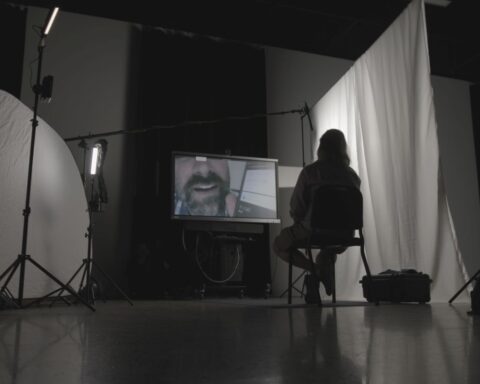OF THE OVER TWO HUNDRED FILMS programmed at this year’s Hot Docs Canadian International Documentary Festival, only one has a title that applies across the board: How to Change the World. Jerry Rothwell’s Sundance-fêted account of the early days of Greenpeace unravels a very specific narrative, but its titular imperative is one that guides every non-fiction filmmaker worth his or her salt—to create something that alters the previous perceptions or discussions around a particular idea or topic. If there is a through-line guiding the Canadian selections at Hot Docs 2015, it may be the idea of documentary filmmaking as a transformative process, one that doesn’t simply represent reality but reshapes it, whether through direct intervention or aggressive rhetoric.
How to Change the World is probably the flagship film in this regard. Skillfully assembled by Rothwell and editor James Scott out of material filmed for Greenpeace’s own archives, the film takes viewers back to the primal scene of the now-internationally aligned environmental organisation, including the fractious, Cain-and-Abel bickering of its main lieutenants Paul Watson and Patrick Moore. The main voice, however, belongs to Greenpeace’s late founder, Bob Hunter, whose memoirs are generously excerpted in between narration by Barry Pepper.
“When I started reading Hunter’s books about that period, what I loved about them was his willingness to be self-critical,” says Rothwell, who remembers watching news broadcasts about Greenpeace as a child in the 1970s. He says that his major goal in How to Change the World was to eschew hagiography, which meant eliding any suggestions from Greenpeace’s current leaders or PR department. “It was important to me that the film was independent of any editorial control from Greenpeace. There was always the concern about how it might reflect on present-day Greenpeace, which although these are its roots, is a fundamentally different kind of creature than the Greenpeace of the 1970s.”
The animal that emerges through the footage in How to Change the World is a scrappy, feral and impressively agile beast adept at absorbing blows: we watch as Hunter and his followers stand up to Russian whalers and Canadian seal hunters while learning to save their most spectacular gestures of defiance and diplomacy for the moments when the cameras are rolling. Greenpeace’s ability to intrigue and even manipulate mass media was crucial to their early success. “I think their other great legacy is more ambiguous–the pioneering of a kind of protest of spectacle, where the power of a particular image can sometimes skew our ability to discuss and respond to it,” says Rothwell. “But in a sense what they did was in response to an emerging world in which, as Marshall McLuhan foresaw, media came to dominate experience. I think now it’s much harder for a single image to have the same impact that Greenpeace’s footage of the whalers’ harpoons had in the ’70s. We’re in a different kind of media revolution, in which the network has more power than the image perhaps.”
How to Change the World considers activism as global spectacle, while Ryan Mullins’ Chameleon profiles a different sort of courage: the rabble-rouser who hides behind a disguise. Shot in Ghana over a period of two years, the film follows Anas Aremeyaw Anas, an investigative journalist whose work routinely exposes criminal activities ranging from illegal abortions to slave labour. An old-school muckraker with a big readership and enemies in high places, Anas’ goal is “naming, shaming and jailing,” but despite the clarity of this mandate, he is a clandestine figure. He works deep undercover and keeps his face hidden at all times, a manoeuvre that allows him to maintain his anonymity and the access it grants him to all sorts of unsavoury situations.
“There were a few ground rules he set early on, framing my shots to conceal his identity,” say Mullins, who contacted Anas through a mutual friend after reading about him in The Atlantic. “But he gave himself up to the process quite readily. It also helped that I was a one-person crew, and that he felt most comfortable with that arrangement.” The filmmaker’s original plan was to follow Anas on one major story, but when he got to Ghana, his subject was wrapping up an assignment involving the pursuit of a fugitive, and Mullins found himself piggybacking on a sting operation. “One day, I’m in Montreal, and the next I’m barrelling down a dirt road in a police car with guns drawn. That became the first scene of the film.”
Mullins says that he drew inspiration from classic spy films in structuring Chameleon, and that he learned to go with the flow. Anas was understandably reticent to divulge too much information in advance of shooting, and the director got used to just showing up and letting things unfold in their own time. Over the course of shooting, Mullins says that his admiration for his subject’s bravery became tempered by ambivalence about his methods, which explains why Chameleon doesn’t feel simply like a hymn to a journalistic hero. “Anas tends to play fast and loose with the ‘rules’ of journalism, because for him, the end justifies the means,” he says. “What works in Canada might not work in Africa, and vice versa. So I would question his approach, but that’s what made him such an interesting character for me. I wasn’t sure where I stood in some cases. My convictions were wavering with the making of the film. “
Despite the shape-shifting implications of its title, Chameleon is finally a portrait of constancy: Mullins succeeds in showing us how Anas’ physical malleability actually leaves his true self open and exposed for all to see. “[He] doesn’t conceal his true identity,” says Mullins. “He may hide his face, but he hasn’t crafted an alter ego. He inhabits this identity at all times. At first, I had trouble with this as a filmmaker, because I felt I wasn’t penetrating beyond the superficial mask that he presented. It took a while to figure out that there was no alter ego with Anas. There is no fortress of solitude. He lives and breathes the role of the crusading journalist.”
There’s a similar quality of performance in Ted Patrick, the subject, though not necessarily the protagonist, of Mia Donovan’s unnerving Deprogrammed, which examines both the proliferation of religious cults in North America the late 1970s and the methodology of one man who has spent the ensuing decades attempting to extricate impressionable young people from their clutches. Taking his nickname, “Black Lightning,” from an African-American comic book hero and seemingly inventing his modus operandi as he went along, Patrick was considered a hero for clashing with Hare Krishnas and the California-based Children of God, but he also attracted controversy for his extra-legal tactics, which included kidnapping and imprisonment.
Donovan, whose last film was the excellent porn-star profile Inside Lara Roxx, has a personal stake in Patrick’s story: her stepbrother Matthew was deprogrammed when the filmmaker was 14 years old, and she remembers meeting “Black Lightning” in the flesh when he visited her family’s home in Moncton a few days later. “My memories of meeting Ted Patrick back then are bitter,” she says, “because he convinced both my mom and Matthew’s dad to go through my room to take away any items that could trigger Matthew to return to the alleged Satanic cult. They took some of my books and records and even art work. I remember being very frustrated by that. And I remember thinking Ted and Matthew’s father were very misguided in terms of what they considered ‘Satanic’.”
The question of public hysteria around religious cults is very much present in Deprogrammed, which integrates a detailed profile of Patrick, whom Donovan contacted again in 2012, with interviews with people he deprogrammed years ago and a general historical overview, which also touches on the Jonestown Massacre. “I was very open-minded and excited to talk to [Ted] because by that time I had started researching the subject of cultic mind-control and intervention strategies, so I understood his place in history and his contributions. I knew that he was the man who invented deprogramming, so I was interested in the bigger picture, in order to understand why they decided to deprogram Matthew.”
As in Inside Lara Roxx, Donovan’s approach is at once unsparing and compassionate: the scenes featuring Matthew are troubling mostly because the filmmaker allows him to narrate his anger and alienation at being subjected to what he describes as a form of psychological abuse at Patrick’s hands. “I think that both films explore characters that are often dismissed or stigmatized,” says the director. “Lara being an ex-porn star who contracted HIV and Matthew being a juvenile delinquent and an ex-con, one similarity between them is that they both, in a sense, had their ‘coming of age years’ interrupted.” The irony here is that Patrick presents himself as a man who tried to reclaim youth that had been literally or figuratively stolen. To her credit, Donovan refuses any sort of definitive judgment on his legacy.
There’s a definite hard slant to Michèle Hozer’s Sugar Coated, whose title scans as a joke: this is a film designed to leave a bitter aftertaste. Taking many of its cues from the evangelical endrocrinologist Dr. Robert Lustig, who has gone on the record many times about how sugar producers have damaged several generations’ worth of kids raised on soft drinks and high-fructose fast foods, the film isn’t much concerned with ambiguity. Sugar Coated is meant as an exposé of an industry that has always couched its transgressions in the artificially sweetened language of public relations.
“I think that I have been preparing myself to do this story my whole life,” says Hozer, whose last two films were about Canadian artists (Tom Thomson and Glenn Gould). “I’ve been a career dieter all my life. I’m also a jogger. I count calories. But who knew that all calories are not created equal?” After attending a lecture on Alzheimer’s in 2012, Hozer was alarmed to hear the speaker make connections between diet and brain disease, and subsequently clicked on one of Lustig’s viral videos on YouTube. From there, she began to shape her findings into a feature-length documentary.
The trick, says Hozer, was to find a format that wasn’t too didactic. “I am not an advocate,” she insists. “I am a storyteller, first and foremost. My job is not to scold the viewer, or hit them over the head with a candy bar, as a good friend of mine would say. Or overwhelm them with a torrent of statistics, factoids and data. I look for patterns in human behaviour that make up the larger story arc. What does the debate tell us about ourselves, about the secret playbook of industry, and the power of social media or contemporary “Mad Men” to manipulate our tastes and desires? I knew that this would speak to a larger audience than a scientific analysis on the dangers of fructose.”
Hozer says that her goal isn’t to reverse the trends she’s illustrating. “That’s a lot to ask of a film—any film. Look at [Charles Ferguson’s 2010 doc] Inside Job. It won an Oscar, but did anyone go to jail?” Instead, she feels that her responsibility as a documentary filmmaker is to generate engagement and to get people to pay attention to the politics of what they’re watching as much as the sugar content of what they’re eating. “I think back to a video I found on YouTube in which a tobacco industry executive states that some pregnant smokers would prefer to have smaller babies, anyway. We laugh about that now, because it’s so outrageous. But that was only a couple of decades ago. Right now, we may be witnessing the beginning of a transformative change in the way we see sugar and the processed-food industry.”
This is how the world changes: one pair of eyes at a time.
Hot Docs 2015 Screenings
How to Change the World
Sun, Apr 26 1:00 PM – Bloor Hot Docs Cinema
Mon, Apr 27 9:30 PM – Bloor Hot Docs Cinema
Chameleon
Sat, Apr 25 5:30 PM – Royal Cinema
Sun, Apr 26 4:30 PM – Scotiabank Theatre 3
Deprogrammed
Sun, Apr 26 6:15 PM – TIFF Bell Lightbox 3
Mon, Apr 27 1:30 PM – Scotiabank Theatre 3
Thu, Apr 30 9:45 PM – TIFF Bell Lightbox 2
Sugar Coated
Sat, Apr 25 7:00 PM – Hart House Theatre
Thu, Apr 30 6:30 PM – TIFF Bell Lightbox 1
Fri, May 1 1:45 PM – Scotiabank Theatre 10
Sun, May 3 6:45 PM – Bloor Hot Docs Cinema








